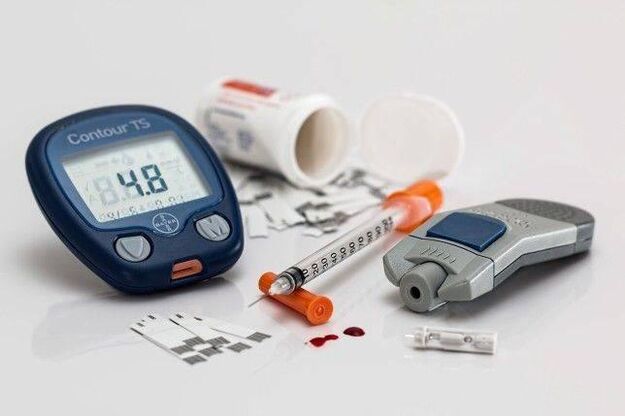
Diabetes is a serious endocrine disease with severe insulin deficiency. The disease is considered incurable, and treating it at home with folk remedies only reduces symptoms.
This disease occurs for many reasons. Viral diseases, genetic susceptibility, medication, or difficulty conceiving can cause flare-ups.
type of diabetes
The disease, such as bronchitis or cough, has distinct signs and symptoms. According to them, 5 types of diabetes can be distinguished.
- 1 typeThe immune system attacks the pancreas, which cannot release the right amount of insulin, which is responsible for glucose metabolism. Traditionally, type 1 diabetes has been a problem for young people. The first type accounts for one in ten cases of diabetes.
- Type 2. Loss of sensitivity to insulin in human organs and tissues. Notably, the pancreas produces this substance in normal amounts. The second disease affects 90% of people with diabetes.
- gestational diabetes. Only occurs in women during pregnancy. Unlike other types of diabetes, this type of diabetes usually goes away after the child is born. Only 5% of expectant mothers experience this condition.
- secondary diabetes. A health condition in which various diseases cause elevated glucose levels. This type is thought to be the result of hormone exhaustion, medication, chronic pancreatitis, or pancreatic resection.
- prediabetes. Appears when there are no health problems. For a long time, the patient's blood sugar level was at the highest level of normal. It is caused by heredity, incorrect lifestyle, malnutrition and obesity.
The first two types of diabetes cannot be completely cured. However, with the help of diet, treatment, and moderate exercise, people with this disorder can lead normal, long lives.
symptoms of diabetes

Symptoms of this disease usually don't appear right away. As a result, the disease remained hidden for a long time without revealing its existence.
In medicine, there are cases where diabetes emerges as a surprise. The patient sought advice from a doctor for a specific disease, and after passing the test, he learned about diabetes.
People often have two types of diabetes, each with its own symptoms. Several common symptoms can be identified.
- Thirsty. One of the main messengers of diabetes, regardless of type. However, other diseases can also cause thirst, so doctors don't focus on this symptom when making a diagnosis.
- frequent urination. This symptom is characteristic of both diseases. Usually, frequent urination indicates a violation of the urinary system.
- fatigue. Lethargy and chronic fatigue are symptoms that accompany various diseases, including diabetes.
- low temperature. In most cases, a person with an illness will have a lower body temperature - below 36 degrees.
- Increased appetite and rapid weight loss. People who often want to eat and lose weight for no reason are advised to be vigilant and get checked.
- low tissue regeneration. With diabetes, even minor damage to the skin will heal over a long period of time. There are often ulcers and tearing wounds.
- Visual impairment. Some diabetics complained of a white "veil" appearing before their eyes and blurry images. But vision deteriorates with age.
- Circulatory disorders of the extremities. Presents as tingling and numbness. Often, cramps occur in the calf muscles.
- decreased potency. Men with diabetes often have erection problems. In women, the disease causes dryness of the genitals.
Remember that the severity of symptoms depends on the characteristics of the body. In one person, the listed symptoms were evident, but not in another. The stage of the disease can also affect the severity of symptoms. Symptoms are more pronounced with severe violations of insulin secretion.
Treating diabetes with folk remedies
Diabetes can overtake a person when the pancreas cannot handle its duties and releases small amounts of insulin. This substance helps the body break down sugar. As a result, excess sugar is excreted in the urine. Although doctors are constantly analyzing the course of the disease, no effective treatment has yet been created.
The use of folk remedies for diabetes at home is permitted under the mandatory supervision of an endocrinologist. The main factor in treatment that affects the course of the disease is diet.
Carbohydrates are excluded from the diet. If this is not possible, their consumption will decrease. It is recommended to use xylitol, sorbitol or products containing starch instead of regular sugar.
The list of folk remedies used to treat diabetes is represented by natural fruits, vegetables, medicinal plants and berries. Often, individual components are used together, which increases the healing effect.
- Clover Infusion. Mix a portion of the clover with an equal amount of boiling water and wait three hours. Take 0. 33 cups of medication before meals. Add flowers to enhance the effect.
- blueberry leaves. Pour a cup of boiling water over a spoonful of dried leaves, wrap it well, and wait 30 minutes for the liquid to infuse. After carefully filtering the infusion, drink three glasses a day.
- walnut leaves. Grate two dozen green walnut leaves, put in a saucepan, pour in a cup of liquid, and boil for 10 minutes. Medication is taken during the day without any restrictions.
- herbal collection. Combine 20 grams of blueberry leaves, birch buds, pansies and nettles, add 5 grams of St. John's wort and 10 grams of dandelion root, mix well and chop. Pour four tablespoons of the mixture into a cup of boiling water in a kettle, wait for a while, filter, and take 0. 33 cups 3 times a day.
- Burdock root. Serve with cooked or fried cheese. Some people substitute burdock root for potatoes and add them to soups and meatballs.
- blueberry soup. Cook a spoonful of leaves and sprouts over low heat, then cool slightly and strain. To treat with this medication, take one scoop 3 times a day.
Because of the severity of the condition, start treatment immediately. The recipe I share will help.
What can diabetics eat

Moving on to the topic, we will discuss what diabetics can eat. According to doctors, nutrition plays an important role in the treatment of the disease because the process of using the glucose from food into the body is disrupted.
High levels of substances in the blood can lead to the development of complications and pathological effects on the body. At the same time, in diabetes, proper nutrition also has a therapeutic effect.
Therapeutic nutrition focuses on the normalization of carbohydrate metabolism. This reduces the load on the pancreas. Eating frequently and regularly, evenly distributing or limiting carbohydrate intake is recommended. The diet should include protein foods and low-fat foods. The list of preferred food processing methods is represented by steaming, braising and roasting.
I will introduce you to foods recommended for diabetics. Many foods are allowed, you just need to keep track of calorie content and carbohydrate saturation.
List of Foods Allowed for Diabetes
- fish and meat. Only lean type. Doctors recommend veal, chicken, rabbit, cod, pike, and pike for cooking. Small amounts of seafood and canned fish are allowed.
- dairy products. Preference is given to skim milk and kefir. Eggs are allowed. Eat two meals a day.
- Flour products made from rye flour and bran. You can also eat pasta in small amounts. Fiber-rich pasta is the best.
- barley, buckwheat, oats and millet groats. Use grains to make porridge or soup. It's best to avoid rice and semolina because they can increase blood sugar.
- fiber-rich vegetables. Broccoli, beans, zucchini, cabbage, eggplant and radishes. Don't overuse red beets and potatoes. Steam or roast vegetables.
- Berries and Fruits. Include tart apples, pears, currants and citrus fruits in your diet. Remove watermelon, melon, raisins, bananas, grapes and figs from your diet.
- meal candy. The composition should include sugar substitutes. Dietary sugar and honey are permitted.
- Pumpkin and Sunflower Seeds. These dry foods are rich in fiber, vitamins, trace elements and beneficial acids. Nuts are allowed, but the daily intake of peanuts or walnuts should not exceed 50 grams.
- drinksDecoctions, teas, preserves, kisels and juices are considered very useful. Non-carbonated mineral water and alcohol with no more than 5% sugar are allowed. Best not to drink coffee.
Also, I'll list several foods and spices that reduce sugar. These are parsley, tomatoes, onions and zucchini, cucumbers, currants and currants, turmeric, ginger and cinnamon.
How to prevent the development of diabetes?
Every diabetic knows that it takes a lot of hard work to live a normal life. Otherwise, disease dictates the rules. Prevention helps prevent the disease from developing and minimizes the likelihood of complications.
The development of the first group of diseases cannot be prevented. There are campaigns for the second type.
proper nutrition. This is the foundation of good health. Remember that being overweight and obese can accelerate disease onset, so be sure to eat right.
In line with water balance. Seventy percent of the human body is water, which helps digest food and remove decaying residues. In diabetes, fluids are involved in many processes.
sporty. Diabetics are overweight. If you exercise, you can stop the disease from developing. Physical activity is an essential element of prevention.
Equally important in life are emotions and mental states. Nerves contribute to the appearance of disease, so for prevention purposes, attend training, consult a doctor, and fight depression.
Do not take medicines without a doctor's prescription or the condition will worsen.
In this article, we examine the types of diabetes, identify the symptoms of the disease, consider home remedies, and figure out what to eat with it and how to take preventative measures. Use your acquired knowledge at your own discretion, but don't forget to consult your doctor. Healthy body!

























